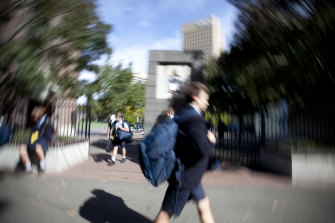Victorian parents are paying the highest median private school fees in Australia, with a price tag this year across all high- and low-fee non-government schools of $14,140.
And in Melbourne’s wealthy private school zone in the inner south-eastern suburbs, the median school fee of $34,246 makes it the most expensive place in Australia to send a child to school, a new report has found.

Victorian non-government school fees are set to rise by an average of 2.9 per cent this year. Credit:Arsineh Houspian
The report by education payments business Edstart said fees for non-government schools were lowest in Melbourne’s west and north, but growing more quickly than the rest of the state.
Many non-government schools froze fees last year, particularly in Victoria, which endured more time in pandemic lockdown than other states. Fees rose by an average of only 0.4 per cent in 2021.
That pause will end this year for most schools, although many have kept increases for 2022 below the inflation rate.
Just 6 per cent of Australian independent and Catholic schools surveyed in the national report have opted to keep their fees on ice this year.
Edstart’s chief executive and the author of the report, Jack Stevens, said non-government schools faced budgetary pressure this year partly because of recent changes to the federal school funding model, COVID-safety measures and the widespread provision of fee relief to financially strapped families during the pandemic.
Victoria’s average non-government school fee hike is on par with the national average of 2.9 per cent.
Parents in NSW, Queensland, Tasmania and the ACT face higher increases of between 3 and 4.26 per cent, while South Australian schools have locked in the lowest average rise of 0.91 per cent.
But annual fee rises have not yet returned to pre-pandemic levels. In 2019, Victorian private school fees rose by an average 3.68 per cent, followed by a 3.16 per cent rise in 2020.
The figures are drawn from Edstart’s 2022 school fees report, which is based on analysis of tuition, boarding and compulsory fee costs at 538 Australian independent and Catholic schools, including 135 Victorian schools.
Mr Stevens said the annual pattern that had set in before the pandemic, of schools raising their fees above the inflation rate, had ceased.
“I think that the days of schools pushing up fees by 5 and 6 per cent, which is what they used to do, are probably gone. What we are hearing from parents this year is that this level of fee increase is probably expected,” Mr Stevens said.
But Melbourne-based education consultant Paul O’Shannassy, who advises families on their non-government school choices, said two years of lockdowns and remote learning had led some parents to question why they were paying such high fees.
He said this was particularly the case when extracurricular activities such as weekend sports, camps, music and drama were unavailable.
“In previous years, every year the letter was sent out with a 3.5 per cent fee rise, that was just standard and people just accepted it,” Mr O’Shannassy said.
“But this year people are saying, ‘Hang on a minute, you’ve saved a fortune on camps and sports and so on.’ ”
Many high-fee schools lost income when they waived or discounted fees for families that suffered financial loss during lockdowns, but would probably seek to end that practice, Mr O’Shannassy said.
Some also received millions of dollars in federal JobKeeper subsidies, before later posting surpluses.
For some families, school fees of more than $30,000 a year are no barrier to enrolment, but some who cannot afford this seek out an academically well-regarded government school for their children and also invest in private tutoring, Mr O’Shannassy said.
Emma Rowe, a senior lecturer in education at Deakin University who has researched school choice in Australia, said many parents were not dissuaded by the sometimes high cost of sending their children to a non-government school.
“It’s almost something of a status setter; the higher the fees, the higher the barriers that it is perceived are there to enrol in a particular school, the greater the sense of prestige. It’s not actually a rational process all the time,” Dr Rowe said.
Parents are often motivated by a school’s religion and values, or by a desire for their children to gain entry to social and professional networks, she said.
The report also reveals that fee rises for this year have not been uniform. For example, coeducational and girls’ schools in Victoria have raised their fees by about 2.7 per cent on average, while boys’ schools have put them up by 4.56 per cent, which is well above inflation.
Melbourne’s north has the lowest median fees of $8159 this year but the steepest increase – 4.49 per cent.
Regional Victorian schools are raising their fees by an average 2.31 per cent to a median $9397 this year.
Thirty-six per cent of Victorian students attended a non-government school in 2020, the most recent national data shows, which was higher than the national average of 34.4 per cent and second only to the ACT.
The Morning Edition newsletter is our guide to the day’s most important and interesting stories, analysis and insights. Sign up here.
https://news.google.com/__i/rss/rd/articles/CBMilAFodHRwczovL3d3dy50aGVhZ2UuY29tLmF1L25hdGlvbmFsL3ZpY3RvcmlhL3ZpY3Rvcmlhbi1wcml2YXRlLXNjaG9vbC1jb3N0cy1yaXNlLXRvLW5hdGlvbi1zLWhpZ2hlc3QtYXMtcGFuZGVtaWMtZmVlLWZyZWV6ZS1lbmRzLTIwMjIwMTI2LXA1OXI5dy5odG1s0gEA?oc=5
2022-01-26 12:45:00Z
1254471688
Bagikan Berita Ini














0 Response to "Victorian private school costs rise to nation’s highest as pandemic fee freeze ends - The Age"
Post a Comment